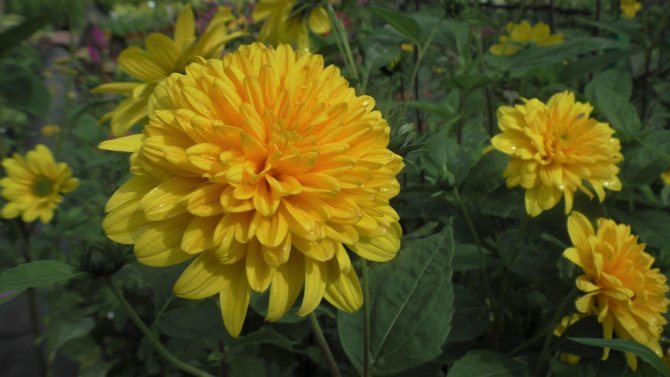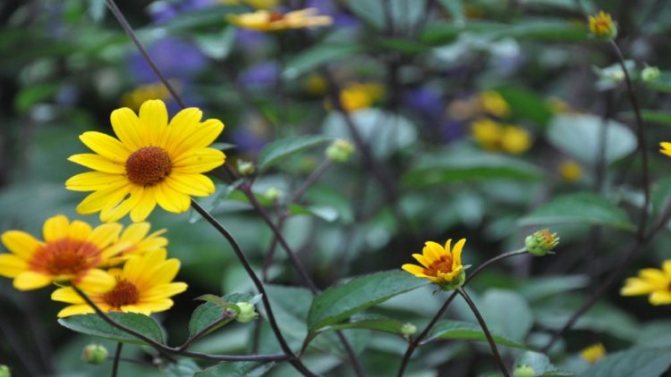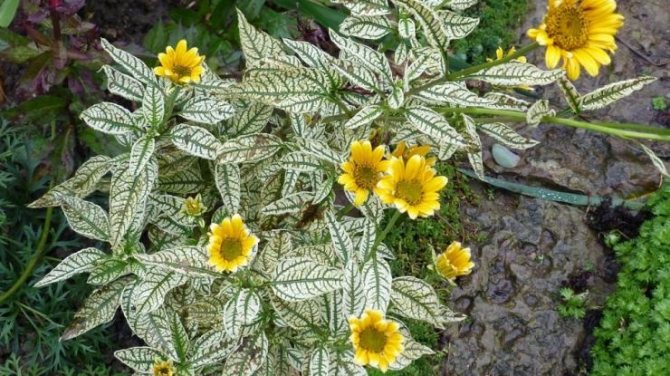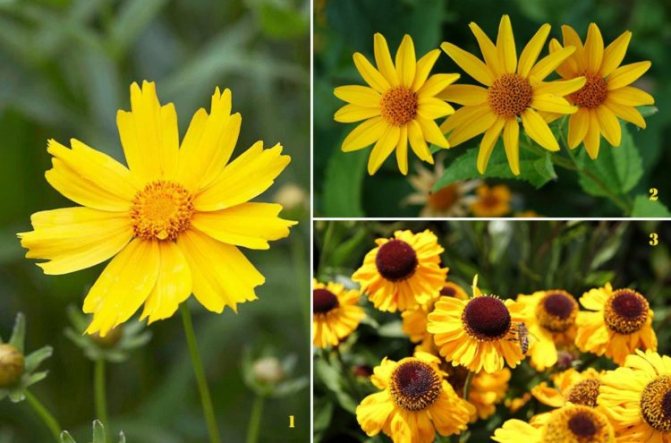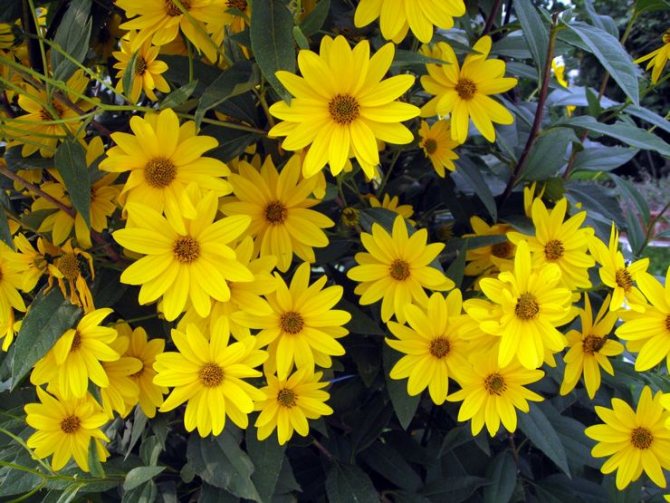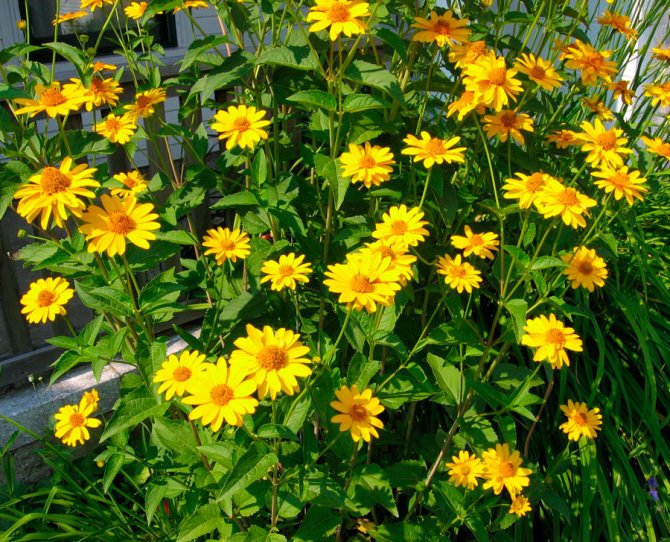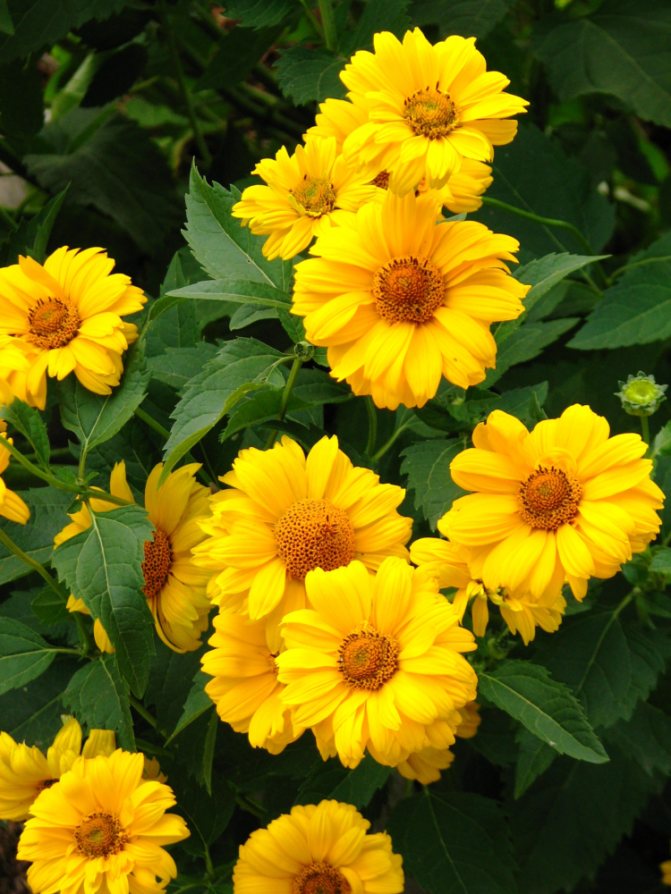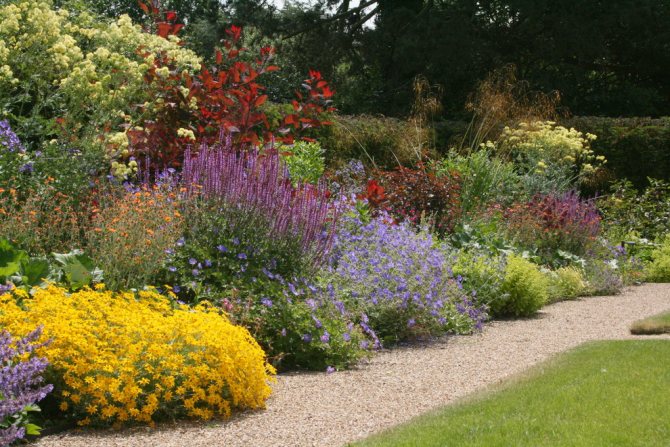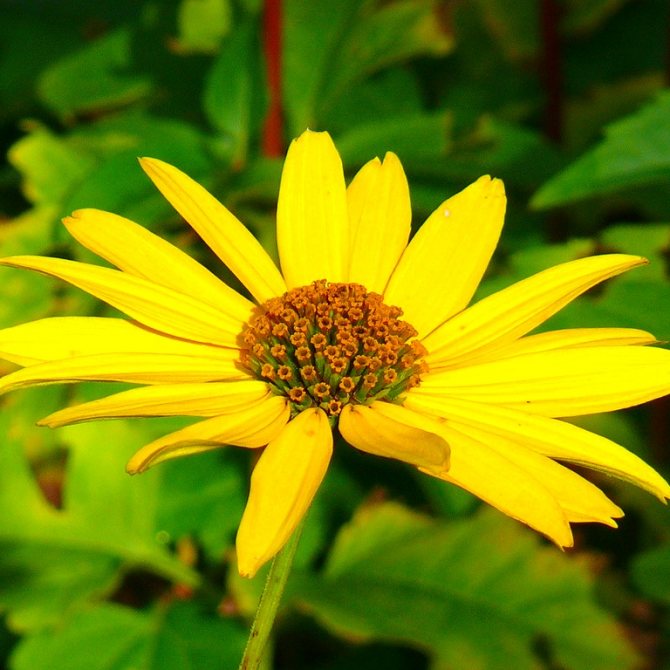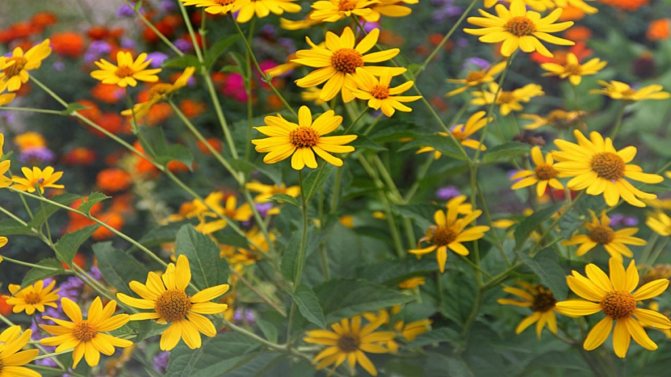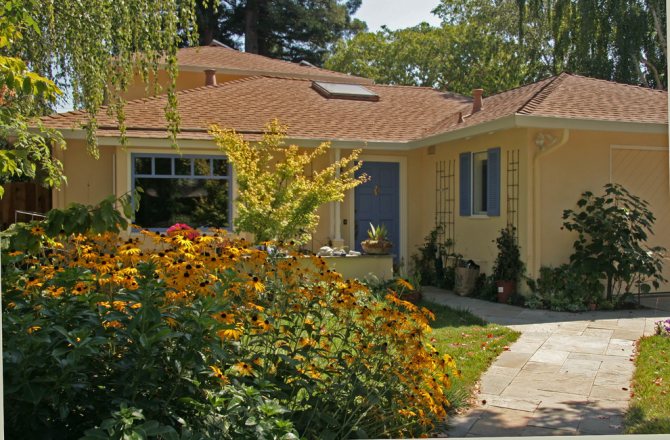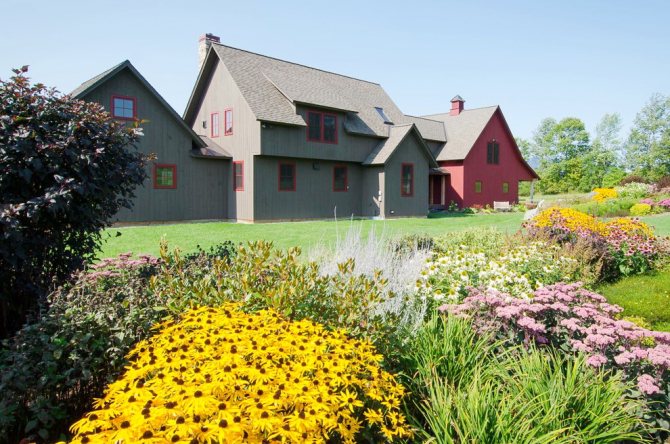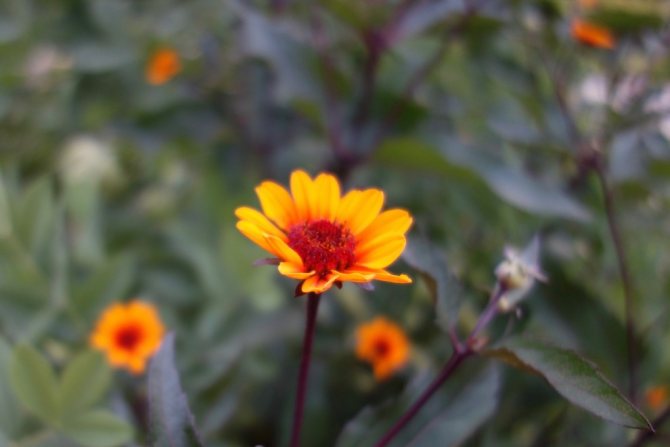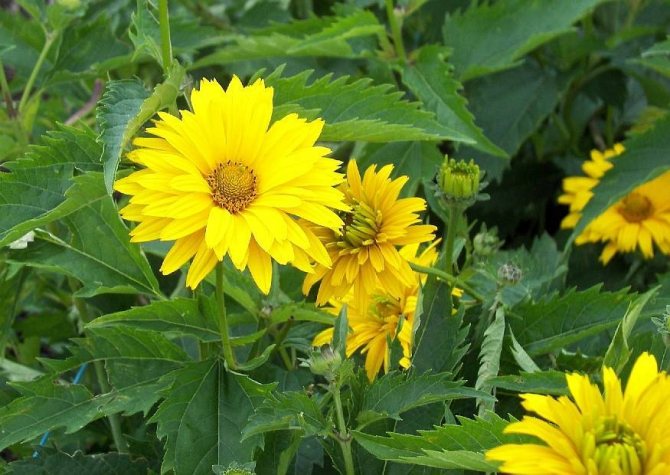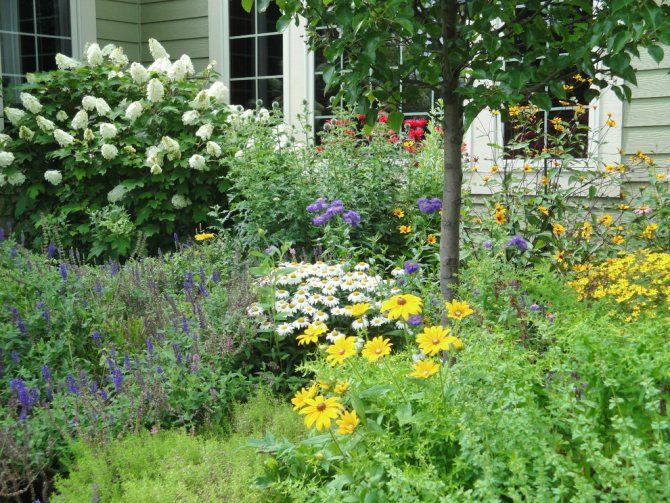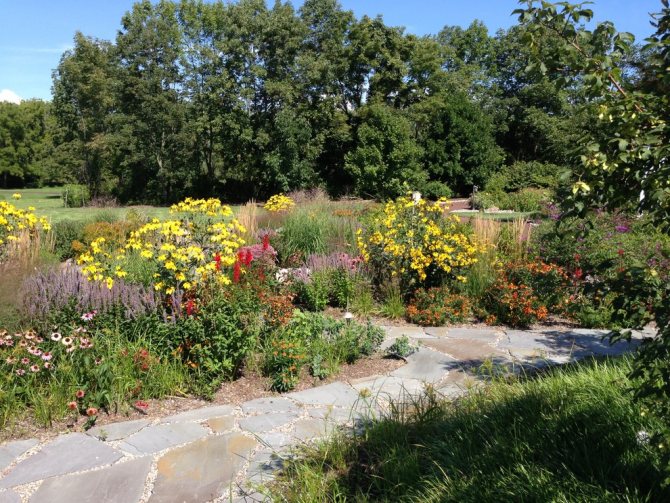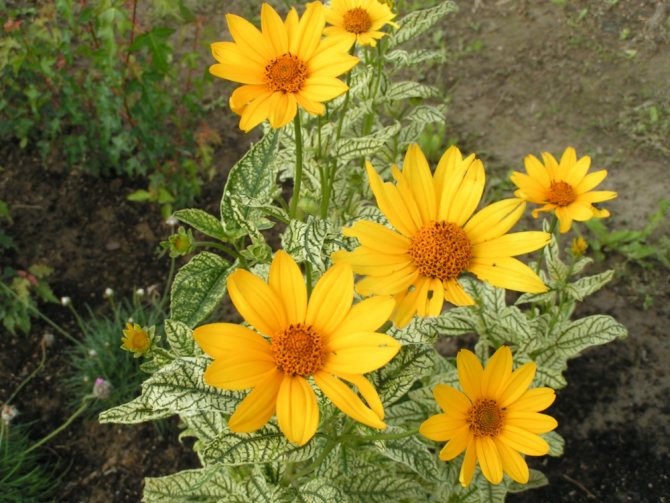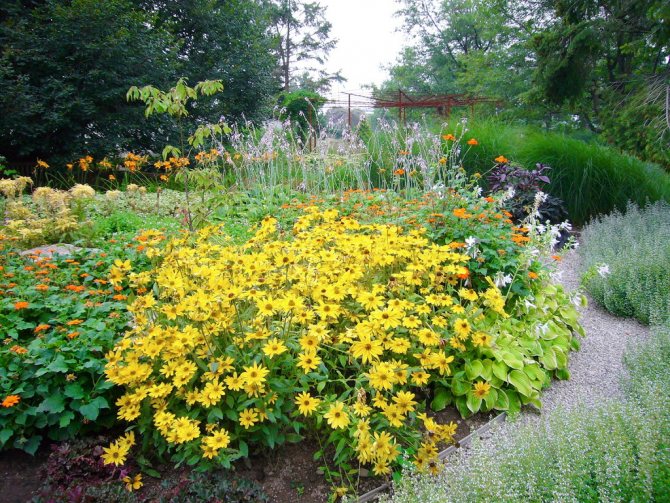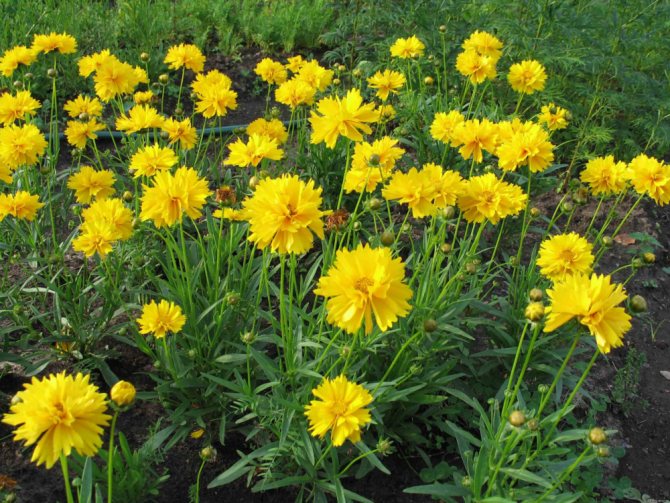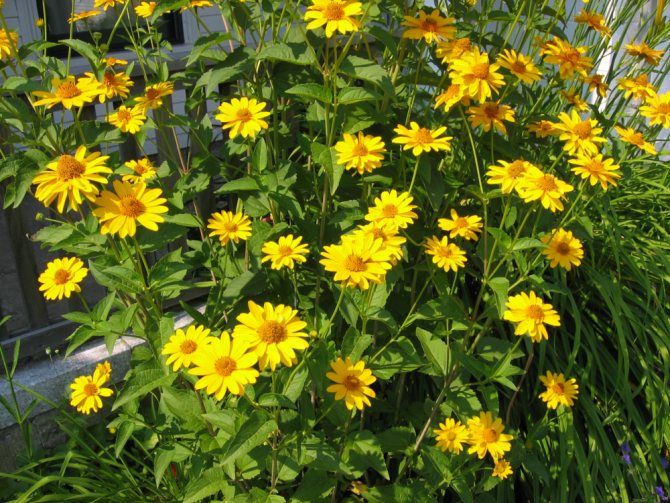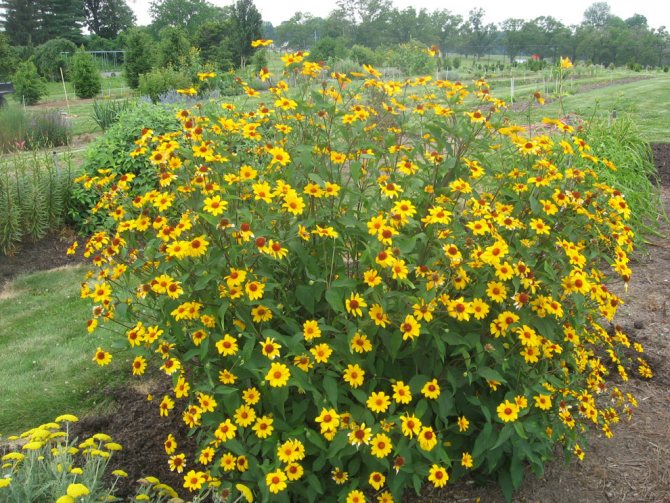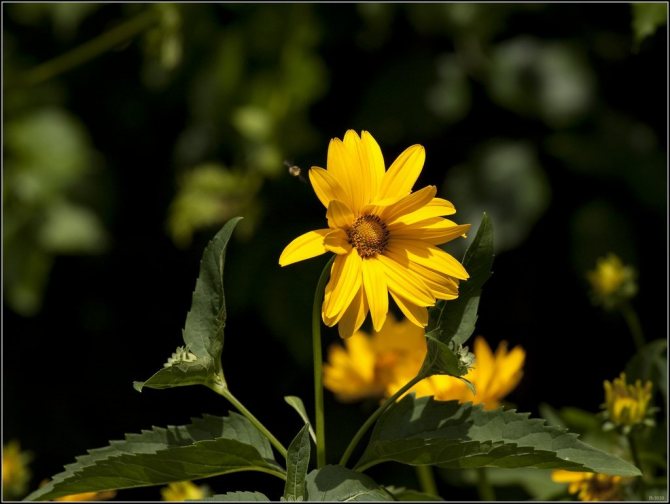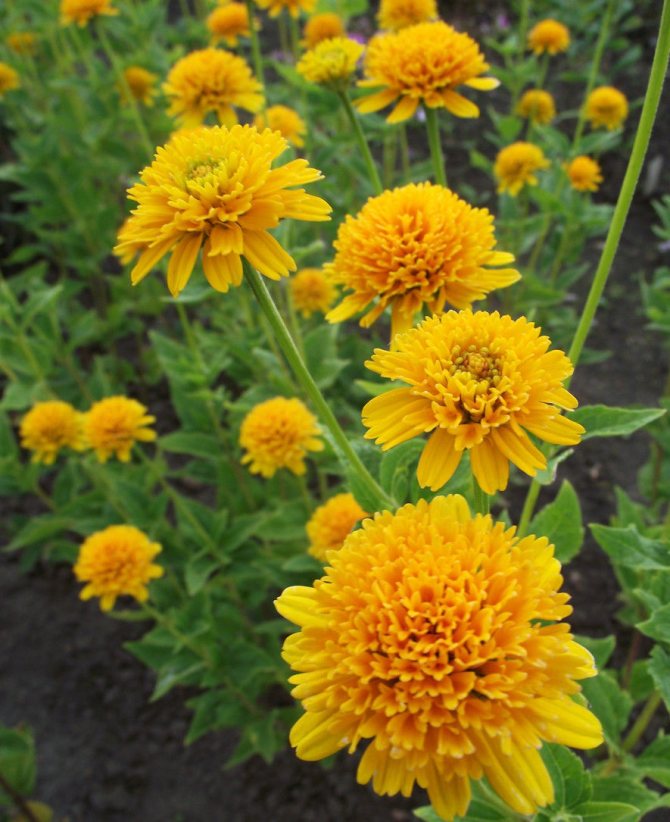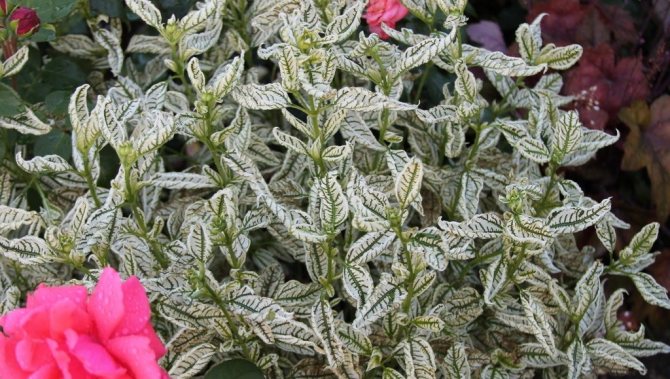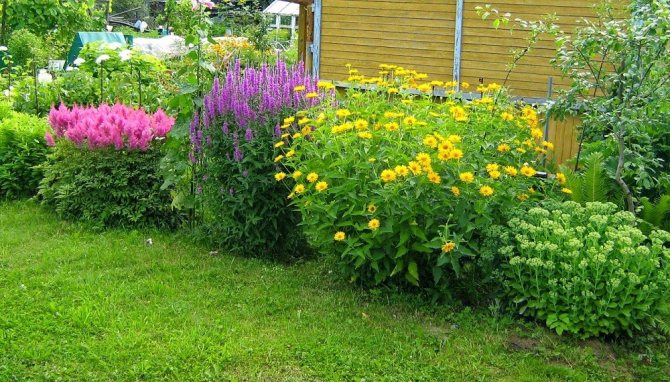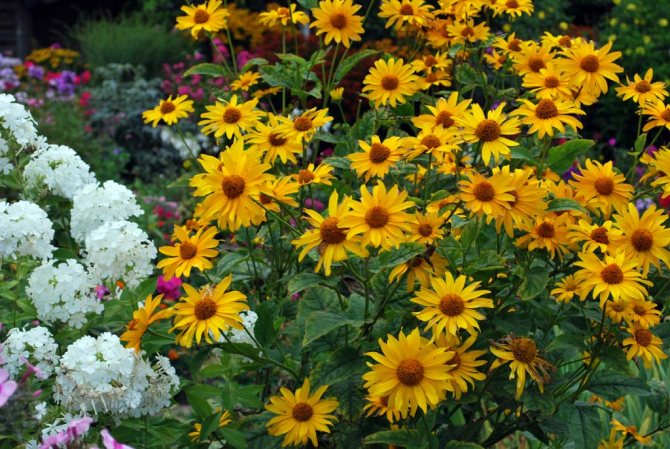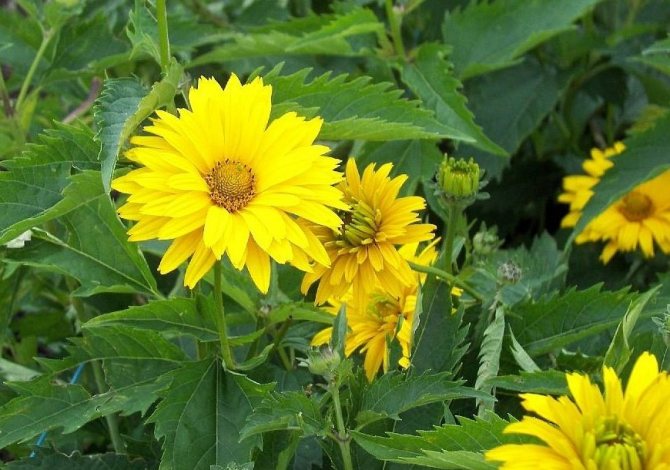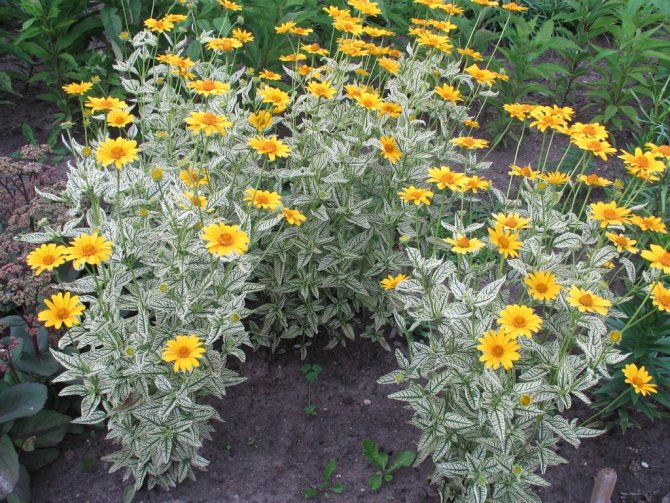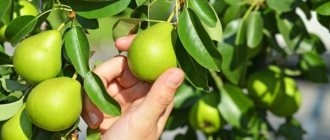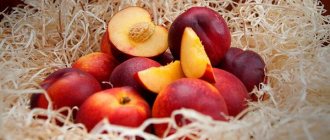Today we will talk about delightfully beautiful plants that can harmoniously complement any structure of modern landscape design, namely, heliopsis. We will tell you how to grow these adorable perennials, how heliopsis multiplies, planting and caring for which in the open field, will open for you an amazing world of the charm of these flowers.

Varieties and varieties
For cultivation in amateur (home) conditions, two types of heliopsis are suitable: rough and sunflower. In turn, these varieties include many varieties and hybrids of the plant.
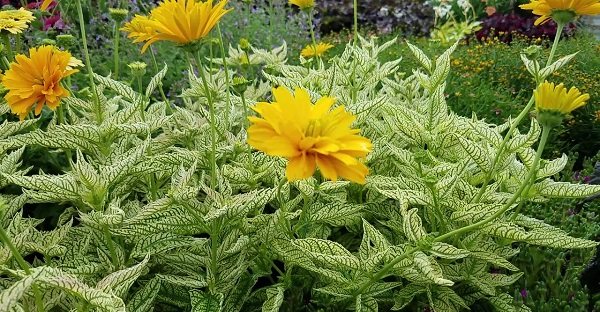

Sunflower
Refers to a perennial variety of shrubs. It has naked, straight and branched shoots that grow more than a meter in height. The leaf plates are pointed, with a toothed border along the edge. The inflorescences are colored golden yellow.
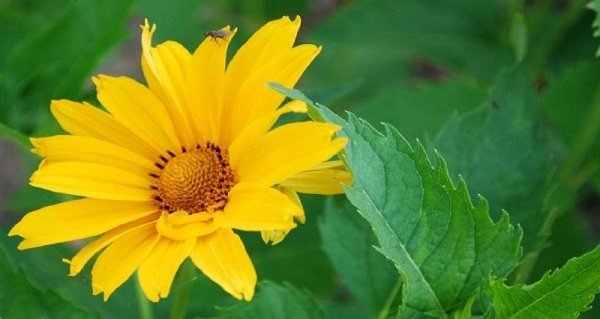

Rough
Formally, this type of heliopsis is considered a subspecies of the sunflower species, but since it has been cultivated for a long time and often, many are accustomed to making it a separate category.
The bush grows up to one and a half meters in height. Branched shoots are crowned with a rough crown, which eventually stiffens. The leaf plates are ovoid (or oval) in shape, the edge is also decorated with denticles. The inflorescences of this species are similar to small baskets, 65-75 mm in diameter. The flowers are in the form of golden tubes.
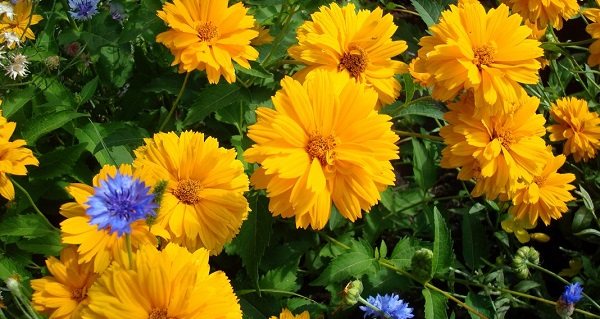

The best varieties:
- Benzinggold... This variety has rather voluminous bushes, which are decorated with terry inflorescences in the form of baskets. In the inflorescences there are bright yellow and orange flowers in the form of tongues;
- Lorraine Sunshine... The bush grows up to a meter in height. Its entire surface is strewn with leaves of a silvery-gray shade with dark green veins. When the shrub blooms, a lot of yellow flower-baskets appear on its "hat";
- Sunburst... The foliage of this shrub has a cream color, on which veins of a dark green hue are clearly visible. The inflorescences are also golden yellow;
- Venus... One of the most powerful varieties that grows over 1.3 meters. Each golden-yellow inflorescence reaches 11 cm in diameter;
- Sommerzwerg. A low shrub (only about half a meter) with lush, dense foliage of a dark green color. Lush flowering, yellow inflorescences with golden tint;
- Sonnenglut. The tall bush is 1.3 meters in height, the inflorescences are large, have an orange-yellow tint;
- Summer Sun Drought-resistant variety that grows up to a meter. Terry inflorescences, each flower reaches 65 mm in diameter and is painted in a rich yellow hue;
- Prairie Sunset. The tall bush (1.7 meters in height) is covered with dark green foliage with purple overflow. The inflorescences-baskets are colored golden-yellow, the core of the bud is decorated with an orange spot.
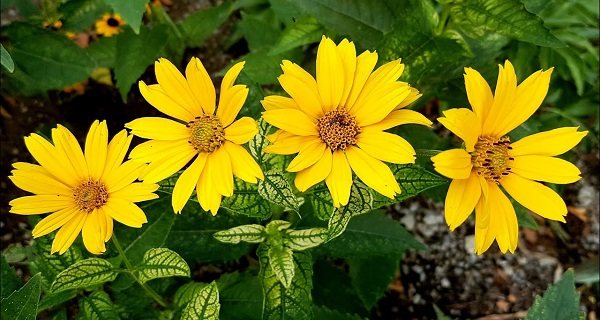

Description of the plant
Straight and branched shoots of heliopsis are about 1.6 meters high. Oblong sheet plates exist both oppositely located and alternately located, their edge is serrated.Luxurious panicles consist of inflorescences, which are semi-double, simple or double baskets, reaching 80-90 millimeters in diameter, they include ligulate flowers of yellow or orange color, as well as median tubular flowers that are orange, lemon and brown. The fruit is a flat, naked achene.
Types and varieties
Heliopsis flowers scattered in the gardens thanks to selection, which gave inflorescences of all kinds, which created varieties resistant to the cold of central Russia and parasites. The ancestor of the overwhelming mass of hybrids heliopsis Sunflower:
- Heliopsis Rough was bred from Sunflower's heliopsis. It got its name for the tough villi that cover the leaves and stem of the plant. In height, this species stretches to one and a half meters. Leaves are arranged oppositely on small petioles. The inflorescence is colored yellow, can reach a diameter of up to 7 centimeters.
- Heliopsis Lorraine Sunshine - undemanding variety with a light aroma. A simple inflorescence basket is bordered by rounded yellow petals. Peduncles rise to a height of 70–80 centimeters. A feature of this variety is the magnificent white leaf color with green veins.
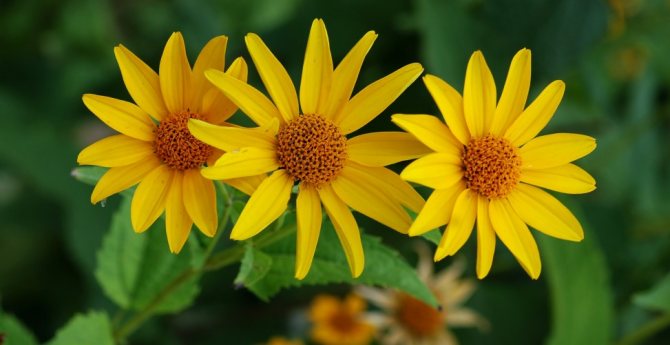

- Heliopsis Summer Knights - a voluminous variety reaching a height of 1.2 meters. Bred by American scientists breeders. It is characterized by a dark, almost brown stem and leaves with a copper-bronze tint. In the center of the inflorescence is an orange-red core. The flower is simple.
- Heliopsis Sunflower - a perennial plant with straight, branched stems, reaching a height of 100 centimeters. The leaf plate is solid, oval in shape, with cracks along the edges, the arrangement of the leaves is opposite. The inflorescence is amber-yellow, reaching 8-9 centimeters in diameter, double or semi-double. Blooms in abundance all summer long.
In the landscape
Sunny flowers of Heliopsis, especially in summer, delight with their bright appearance, raise health. This plant is suitable for various nooks of the garden and any flower arrangements. Typically it is used:
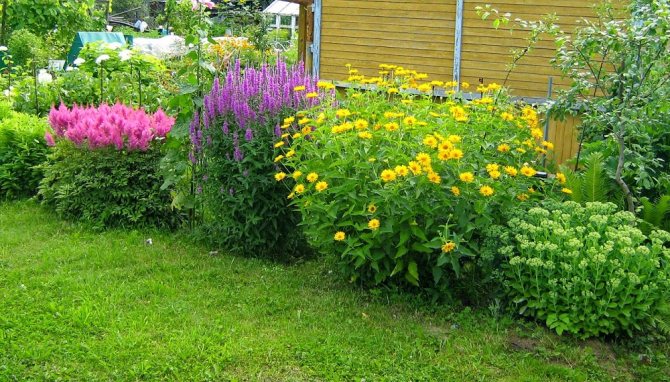

- In mixborders, these are design plantings based on planting plants of various levels and different flowering periods. Heliopsis is perfect for backgrounds;
- Solitre plantings, that is, isolated plantings;
- Near the walls of buildings and various fences;
- In flower arrangements, it is best combined with blue and purple flowers (marigolds, bells, asters, cornflowers, etc.).
The large growth and bright flowers of Heliopsis, blooming for more than two months, will decorate any garden and will endlessly delight with their sunny appearance.
Growing from seedlings
It is important to remember that the seeds of this must be sown in late February - early March. These terms are optimal, since then the finished seedlings can be transferred to open ground in May.
Planting seeds for seedlings and taking care of seedlings:
- Pre-prepared seeds are planted in containers with nutrient soil. It can be ordinary garden soil, flavored with humus, and a purchased substrate, created specifically for indoor flowers;
- Since the heliopsis seeds are quite large, you can use ordinary plastic cups for planting, each of which will fit one seed. There must be a drainage (hole) in the cups so that excess moisture goes through it and does not stagnate;
- If the planting will be carried out in containers, then you need to plant each seed 5 cm from the previous one. The depth of the hole for each seedling must be at least 1 cm;
- Seeds sprout for a long time. Usually, the first shoots begin to appear 14-21 days after sowing.You can, of course, speed up the process by creating homemade greenhouses (cover containers with cling film), while it is important not to forget to open the greenhouses every day to air the plantings;
- Water the seedlings sparingly, making sure that the soil does not become too waterlogged (to avoid the formation of mold and mildew). Overdrying the soil is also not worth it;
- The room temperature should be + 19..20 degrees, while the sunlight should be bright, but diffused. In such conditions, the landing is kept for 7 days;
- Next, you need to transfer the seedlings to a cooler place (+ 14..16 degrees) and leave there for a month;
- In the 20th of April, you need to start hardening the plant. To do this, take it out into the fresh air every day (first for an hour, and then every day increasing the time up to 24 hours);
- Landing in open ground should take place in early May. A distance of 38-40 cm should be maintained between each seedling (between rows 65-70 cm). It is important to plant carefully, without damaging the root system. (it is good to water the plant before planting so that the earth softens). The first 10 days, you need to water the crop well to speed up adaptation.
On a note! If the seeds are fresh, then you can plant them immediately, but if they have been lying for more than a year, then it is best to first wrap them in a wet cloth, cover them with plastic and keep them in this state in the refrigerator (in the vegetable compartment) for a month.
Planting and breeding
The perennial loves well-lit, protected areas of the garden. It has a strong root system that can penetrate to great depths. It is thanks to this feature that the plant grows well on ordinary garden soil, moderately impenetrable, moisture-absorbing. Dislikes places prone to flooding and liquid stagnation.


- When deciding when to plant heliopsis, they proceed from the distinctive features of perennial seed germination and the possibility of vegetative reproduction:
- Winter sowing of seeds is carried out in October, the plant blooms by the next summer.
- Heliopsis is also sown with seeds in the ground in April-May, but flowering in this case begins the next year.
- In February-March, the flower is sown for seedlings.
Advice! Planting by layers of rhizomes and young shoots is desirable in the spring, so that the bush takes root firmly.
Sowing in open ground
Sowing heliopsis is absolutely simple: it is quite simple to lay out the seeds one at a time in a small garden. If you do not have enough perseverance, then you will have to dig in or transplant excess shoots to another place. Taking into account that the plant is tall, you should leave the distance between the rows at least half a meter, and preferably 60–70 centimeters.
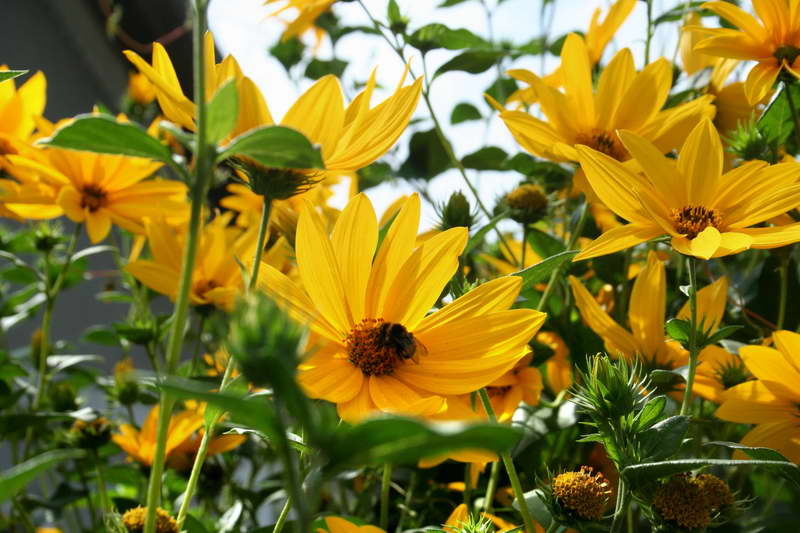

In a row, you can allow a gap of 20-30 centimeters between the bushes, and then as long as they grow a little. Then they should be removed through one or dived, so as not to clog each other. The planting depth is 2-3 centimeters, the furrows are made shallow in order to make it easier for the plants to move towards the sun. Don't worry: the seeds germinate slowly, up to three weeks.
The sowing period is quite free: in the fall, of course, you should not sow too early, so that the seeds do not hatch. Calculate according to the weather: it happens that sowing is done in October, however, during a sultry autumn, it is advisable to shift it to November, if the soil still makes it possible to perform work.
In the spring, at the end of March-April, after the land dries up, you can start sowing. The main thing is that the soil is not too moist. The seeds will sprout in advance, and the flowers will certainly be much more magnificent in the first year, if you do not delay sowing. However, you can of course sow in May and early June.
Sowing seedlings
For seedlings, seeds are sown in February - March, in order to have time to implement the planting of seedlings in open ground in early May.
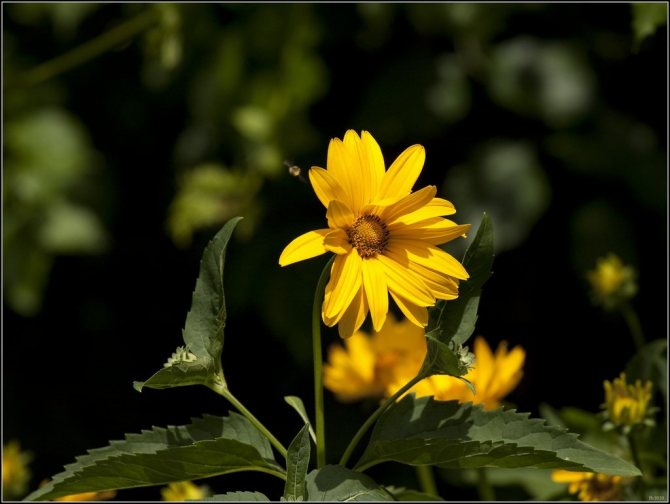

Fresh seeds can be planted immediately, but those that have been lying for more than a year should be stratified.This is not as creepy as it seems: you just need to wrap the seeds in a damp cloth, put them in a plastic bag and keep them in the refrigerator for at least a month (the vegetable compartment is best):
- The prepared seeds are planted in a nutritious substrate. This can be ordinary garden soil, enriched with humus, or a commercial potting soil mixture for home flowers.
- Considering that the heliopsis seeds are quite large, you will have no problem planting them one at a time in separate cups. So you can immediately resolve the issue with the pick: it will not be required in the future.
- The cups must have drainage: holes for excess liquid to drain.
- If you are sowing in a box, try to maintain a distance of at least 5 centimeters between seedlings.
- The embedment depth is small, one centimeter is enough.
- Seeds can sprout slowly, up to 2-3 weeks. To speed up the process, you can create greenhouse conditions: cover the containers with cling film and air them once a day.
- Watering is required in moderation so that various putrefactive diseases do not develop. But you should not overdry the substrate either. In general, everything is in moderation.
- Plants respond well to attention to them and move quickly into growth. All that is required is to take care of soil moisture and provide balanced lighting. After all, heliopsis not only looks like the sun, he loves it very much.
- In the 20th of April, when the seedlings grow, you can safely start hardening them. Starting from one hour, increase the time for “walking” in the fresh air, bringing it to a whole day.
You can plant in early May, keeping a gap in the row of 35-40 centimeters and row spacing of the order of 60-70 centimeters. It is necessary to plant carefully, so as not to damage the roots: it is better to properly water the seedlings before planting and carefully remove the plant from the cup with a lump of soil. So the transplanting process will be comfortable and the plants will practically not get sick. Do not forget, however, to ensure optimal watering for the first 10 days, until the seedlings are completely rooted.
Dividing the bush
Plants that are 4–5 years old may be suitable for this propagation method. The shrub is carefully dug up and its rhizome is divided into equal parts so that there is at least one bud on each division.
After that, they are immediately planted in the ground at a distance of 30-40 centimeters from each other. The procedure is recommended to be performed in spring or autumn, it is recommended no more than once every 4–5 years.
Planting seeds in open ground
Planting seeds in open ground should also not cause difficulties even for an inexperienced gardener. You just need to put one seed at a time in shallow holes. The beds should not be too large.
Seed planting rules:
- This flower is not particularly whimsical, so you can plant it in almost any corner of the garden. It is best, of course, to choose places in the open sun or in partial shade, since in the shade the heliopsis shoots will begin to stretch out to the detriment of the inflorescences. From this, the flower will bloom poorly and look unpresentable;
- The soil at the planting site should be moderately fertile and slightly loose (so that air and water can reach the roots in abundance). Since in their historical homeland heliopsis grow on poor soils, it does not need special additives and fertilizing. In addition, over-fertilization can lead to active growth of the green part of the plant and suppression of flowering. If the site is on black soil, then first you need to dilute the soil at the planting site with sand;
- During disembarkation, observe the distance between the beds. It must be at least 65-75 cm;
- There should be 25-35 cm of free space between each seedling (until the seedlings grow up). Enough grown seedlings will need to be removed through one or transplanted to another place so that they do not squeeze next to each other;
- The depth of each hole should be 2-3 cm, the furrows should also not be deep, because, otherwise, the sun's rays will not reach the seedlings. Seeds sprout in about 2-3 weeks;
- You can plant heliopsis in the fall, but not too early, since the seeds can sprout. It is important to be guided by the weather: you can sow in October, but if the autumn is warm, then you can shift the dates to November (if the soil is still warm enough). If you plant seeds in the spring, then you need to focus on the end of March - early April (as soon as the earth dries up a little). You can choose for sowing May or June, but then the flowers will appear much later or not at all this season.
Varieties and description of heliopsis
The sunflower is a fairly tall plant, reaching a height of almost 150 cm, while its smallest relatives never grow below 70 cm.The flower has bright yellow petals with denticles along the edges, located alternately or opposite each other, depending on the variety.
The most popular varieties of heliopsis:


Will be a bright accent in any interior
Plant care on the site
Heliopsis is not too demanding in care, so any amateur florist can handle it.
Watering
It is important to stick to the golden mean when watering. Both overkill and lack of water can harm the plant. It is necessary to take into account the weather conditions: on especially dry and hot days, you need to water heliopsis 2-3 times a week, on rainy and cloudy additional watering is not needed. It is best to water the crop early in the morning or in the evening (before the heat arrives). After each wetting, it is recommended to loosen the soil.
Top dressing
Heliopsis is used to poor, depleted soil, so there is no need to fertilize it. If desired, you can use ordinary green complex dressings or mineral mixtures. They will add flowering and decorativeness to the bush.
Pruning
Heliopsis are rather large and spreading plants, but, despite their massiveness, their shoots are fragile and brittle. Sometimes too weak roots cannot withstand massive inflorescences and foliage, and therefore the bush breaks up into many smaller parts.
Tall varieties are the hardest. To support the overgrown shrub, you need to use ring-shaped props. You can try and manually shape the bush so that it branches, but does not grow higher. To do this, pinch the tops of the shoots (or simply cut them off) to stimulate the flower to grow to the sides. Such pruning can lead to the fact that the buds appear a little later than usual, but this is not critical.
Heliposis varieties
Title Description Photo Lorraine Sunshine
In addition to beautiful sunny flowers, it has another distinctive feature - beautiful variegated leaves
Summer sun
A bush with the largest flowers that resemble a sunflower as much as possible. This is the largest "sun" in size among other Asahi subspecies
The middle is almost invisible, the shape of the flower looks more like a mini-dahlia than a chamomile. Despite not being very tall, it is an elegant and incredibly lush variety. Due to its relatively low location to the ground, it does not require additional Summer Pink supports
Like Lorraine, it stands out more with leaves than inflorescences, each leaf has a purple color, shades closer to purple, while all the veins of its amazingly emerald gamut. Such rich shades in contrast emphasize the brightness of the yellow petals. Quirky and shape - the edges are slightly bent inward
Goldenfielder Each calyx is filled with several tiers of petals of different lengths


Bright handsome heliopsis
Diseases and pests
Heliopsis rarely gets sick. However, he is capable of being struck by powdery mildew. If white spots and plaque appear on the leaf plates, then this means that the plant is sick. All affected leaves must be removed, and the rest of the bush must be treated with a 0.5% solution of colloidal sulfur. Repeat the procedure until the flower is completely cured. After the plant is sick, you will need to fertilize the soil in the fall. For this, it is recommended to use Fundazole or copper sulfate.
In especially hot weather, the risk of attracting aphids is high. To eliminate it, you need to use standard insecticides (Aktara, Decis, Fitoverm and others).
Secrets of Success in Growing Heliopsis
- Clayy, but well-drained soil on the site for their planting.
- Do not indulge heliopsis with too rich humus, soil - the plant will begin to fatten to the detriment of flowering.
- He only needs a sunny location. In the shade, heliopsis bloom worse, stretch out and are more susceptible to the disease most often found in them - powdery mildew.
- The plant does not need frequent watering.
- Heliopsis grows successfully without shelter even in Siberia, BUT! It can blow out in years with frequent thaws and in areas that are heavily flooded in the spring.
- Timely removal of faded baskets stimulates abundant and uniform flowering.
<2019, Planting a Garden. All rights reserved.
Similar posts
Garden in September
Elegant verbascum candles
Dividing and transplanting chives
Reproduction methods
Heliopsis can be propagated in two main ways: by seeds and by dividing the bush.
By dividing the bush
The procedure should be carried out in the fall or spring. To do this, an adult (4-5 year old) overgrown bush is dug out of the garden bed, the rhizome is cleaned of soil and divided into segments using a sharp, clean knife. You need to divide so that at least one kidney is present on each root. After that, the plant is planted in a new place, having previously prepared the soil.
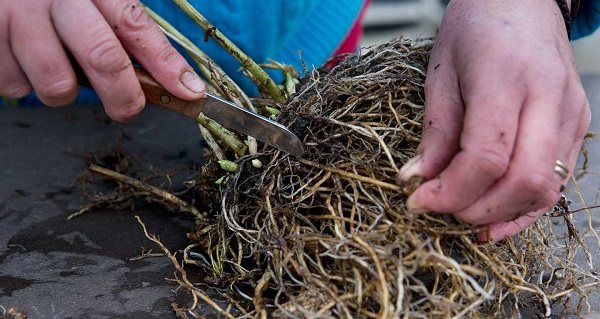

Seeds
It is best to plant heliopsis from fresh seeds. Usually they are planted before winter (October-November) or early spring (March-April). For seedlings, you need to sow seeds in February. Seeds that have been lying for more than a year must first be stratified.


Description of species of perennial varieties Heliopsis helianthoides
Large-leaved hydrangea blooming on the shoots of the current year
There are about 15 types of heliopsis. Some of them are perennial, others, on the contrary, grow only for one year. Varieties differ in appearance and have certain characteristics.
Sunflower
This type includes classic plants. Sunflower heliopsis reaches 1 meter, leaves with jagged edges, there are few of them. Inflorescences are large, bright yellow. The core resembles a chamomile, but is larger in size.
Variegated
Plants of this species are distinguished by the variegated color of the leaves. Due to the presence of mutant cells that are unable to produce chlorophyll, light spots and streaks gradually appear on the leaves of heliopsis variegated.
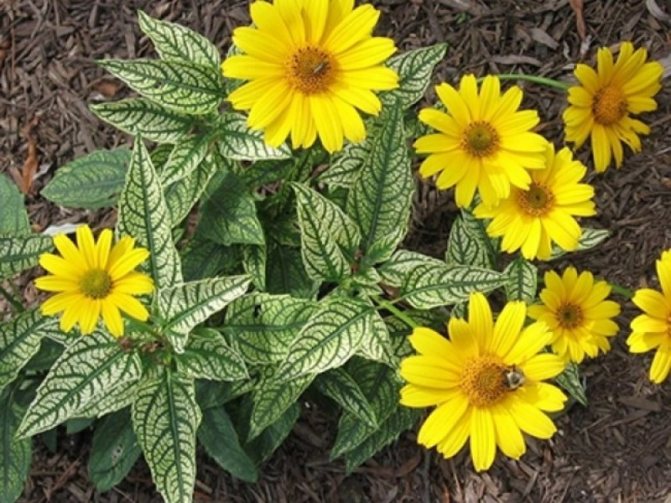

Variegated heliopsis
Rough
Also referred to as sunflower. The length of the rough heliopsy reaches one and a half meters. The plant is distinguished by large buds and large flowers, the leaves are large and rough to the touch.
Terry
Terry varieties are distinguished by inflorescences with a large number of petals, which makes the flower volumetric and gives it an attractive appearance. Such types of terry heliopsis look very elegant.
Others
Quite a lot of plant varieties have been bred. They differ in height, shade of petals, splendor of inflorescences. Some varieties of petals are few, and they are arranged in a couple of rows - these are smooth or simple "baskets".Those with slightly more of them are semi-double varieties.
Heliopsis in landscape decoration
These flowers are perfect to complement a Provence style garden. It is best to plant them in the same flower bed with phlox, calendula, delphinium. It is recommended to choose tall varieties for decorating a hedge or curb.
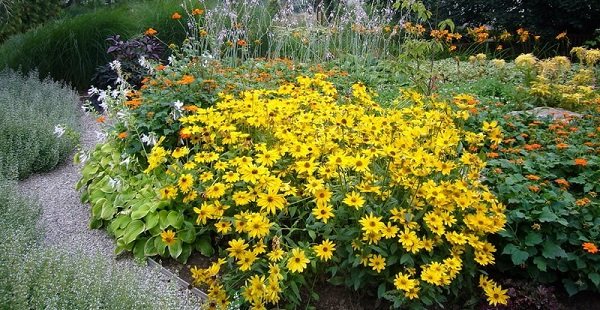

You can see heliopsis on personal plots quite often. This bright and unusual flower can decorate any flower garden. The plant is unpretentious in care, not prone to the appearance of diseases, does not attract pests. In addition, it tolerates low temperatures well and is suitable for growing even in the Ural regions.
The video will add more useful information about planting and the rules for growing perennial Heliopsis in the open field:
Heliopsis in landscape design (ideas and photos)
Landscapers often ditch pompous roses and other well-groomed beauties in favor of simple mini sunflowers because of their long-lasting brightness. They captivate not only with their ease of care and a long flowering period: as it turned out, heliopsis fits perfectly into many group combinations with other plants.
Note! Heliopsis shines very succulently among undersized needles and green bushes. It looks especially beautiful next to flowers of blue and purple shades, as well as spicy herbs.
In addition to aesthetic pleasure, our sunny friend can serve as a practical hedge. Well-groomed and well-formed bushes perfectly zone the space of summer cottages.
Advice! Heliopsis fits perfectly into any idea in the style of country, Provence or rustic design, if it is skillfully combined with cereals, wicker decorative baskets and small wooden carts, or simply planted along the fence.
This modest child of the sun amazes with its unpretentiousness and simultaneous ability to cheer up in one second with bright flashes of petals. Treat him with tenderness, give him a bright corner, occasionally water, feed, tidy up thick hair - and he will consistently give you hundreds of little suns that delight the eye since the beginning of spring and especially warm the soul with autumn gray weekdays!
Lorraine Sunshine: leaving
The plant is considered completely not capricious, does not require any specific procedures, but this does not exempt the gardener from the obligatory activities that every flower needs.
Watering and soil care
Perennial, does not need daily watering at all. Water procedures should be carried out only if the ground around the plant is very dry.
Moreover, heliopsis can do without watering at all, but in this case, you need to understand that flowering will not be abundant and large-flowered. The land around the shrub should be regularly loosened, weeded and mulched.
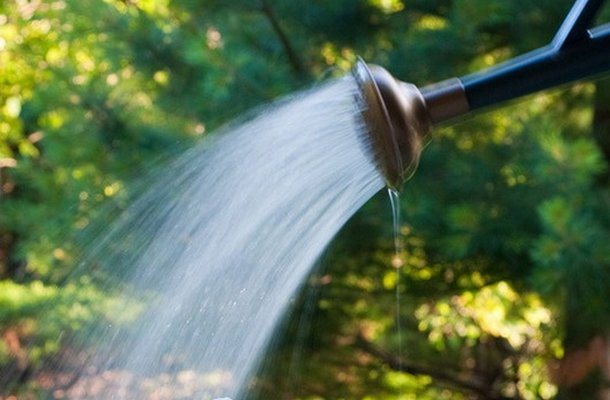

Top dressing
Fertilizing the plant is not at all necessary, but if you want to pamper your pets, then mineral fertilizers and green complex dressings are only welcome. They promote more abundant flowering and add decorative effect to the already charming leaves.
Did you know? In addition to its decorative qualities in a flower bed, heliopsis can be used in floristry, with its help you can create extraordinary sunny compositions, especially when it comes to the Lorraine Sunshine variety. Unusual white leaves in contrast with yellow flowers will help create a unique bouquet that will stand in a vase for a long time and delight with its beauty.
Preparing for winter
All varieties of this plant are considered winter-hardy, including Sunflower-like Heliopsis, Lorraine Sunshine, Summer Pink and many others. It is enough to cut the greens in late autumn, and the perennial is considered prepared for wintering; no special shelters are required.
Heliopsis seed cultivation
Eustoma lisianthus flower, planting and care, photo
Sowing seeds for seedlings.
The flower is grown by seedlings and seeds directly into the open ground. Seeds are sown under the open sky at the equator in spring or late in the autumn season, sowing for seedlings is carried out at the end of the winter season.
When growing heliopsis by seedlings, it is necessary to prepare a soil mixture, it must be enriched with coarse sand, soddy soil and peat in a 1: 1: 1 ratio. The substrate is spilled with a strong solution of potassium permanganate 15 days before sowing the grains, after this procedure, the container is covered on top with glass or polyethylene. Right before sowing, the soil mixture should be poured into a container, its bottom should have drainage holes, also remember that you need to lay a good drainage system, which includes expanded clay. Next, it is necessary to level the surface soil layer and distribute the grains over it equally, then the container is covered with glass or polyethylene on top and rearranged in a well-lit and warm place with temperature conditions of about 20 degrees, the seedlings will live here for seven days. Do not forget that plantings require bright, but diffused illumination by the sun's rays. After that, the seedlings are transferred to the coolest room with a temperature of 3-4 degrees, here they will live for a month, during this time period the grains are stratified. At the end of the stratification, the box is transferred to a warm room with a temperature regime of 25-28 degrees. Remember that it is necessary to regularly remove the covering material in order to ventilate the crops, and also remove the accumulated water droplets from the surface of the shelter.
The covering material is removed completely only after the formation of true leaves in the seedlings. Seedlings dive when they have the first pair of true leaves. For picking, peat glasses filled with soil mixture are used (the composition is the same as for seedlings). After picking, the seedlings are transferred to a colder room with temperature conditions of 13-15 degrees. Seedling care is easy, timely watering is required, regular loosening of the surface layer of the substrate.
Preparing heliopsis for winter
As mentioned above, heliopsis are unpretentious, hardy and resistant to severe frosts. For this reason, plants do not need any special shelters for the winter.
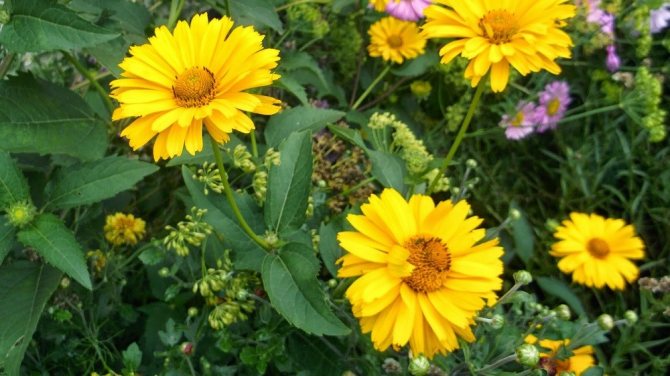

Heliopsis do not need winter shelter
To preserve the flower until next year, it is enough to cut the greens just before the onset of frost, and we can assume that the perennial is ready to winter.
Sunny assortment
Sunflower Heliopsis is loved by European gardeners, the bulk of the assortment came to us from there. As a result of many years of selection, unique varieties with terry baskets resembling golden balls have become, and the color range of flowering has been expanded.
Many of them are bred on the basis of rough heliopsis, a popular variety that forms a powerful bush with a large number of lignified stems and semi-double flowers. It is called so because of the rough leaves, which look and feel like a sunflower. His offspring have high decorative properties and unique charm.
- Heliopsis variety Golden balls is a voluminous sheaf of full baskets on strong, highly branched stems, collected in a bush. In the midst of flowering, dark green lanceolate leaves are practically invisible behind the abundance of inflorescences. The first buds bloom in June, the decorative effect remains until October.
- Interesting heliopsis Lorraine Sunshine. One-meter stems are decorated with variegated leaves - white with green, as if painted, venation. The flowers are simple, daisy-like with yellow petals and a convex orange center. Due to the variegation of leaves, it decorates the garden regardless of the flowering phase.


Lorain Sunshine is remembered for the original foliage - Noteworthy is Asahi's heliopsis - a variety with a compact bush and medium-sized double flowers without a center. Stems are thin and strong, covered with dense shiny leaves.
- Any garden will be decorated with large-flowered varieties of German selection with rich orange colors from the "space" series - Mars, Jupiter, Venus, Karat. Crosses continue to produce variegated varieties of heliopsis.
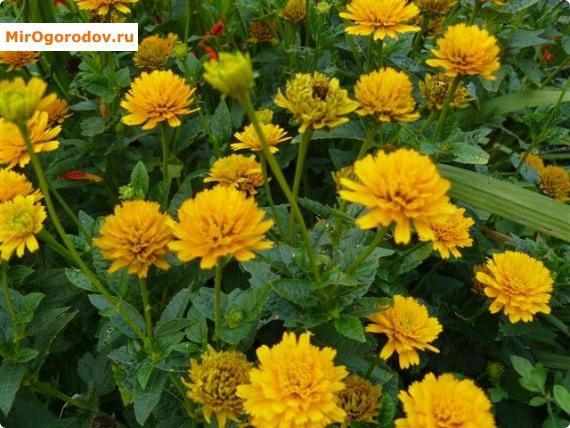

Asahi's golden baskets delight the eye until late autumn
Features of growing a perennial crop
An indisputable plus of growing heliopsis of ordinary and variegated varieties is easy planting, good plant survival and minimal care. Consider the main elements of flower agricultural technology.
Where and when to plant?
Perennial prefers well-lit, sheltered areas of the garden. It has a powerful root system that penetrates to great depths. Thanks to this feature, the plant grows well in ordinary garden soil, moderately dense, moisture-consuming. Does not like areas prone to flooding and moisture stagnation.
When deciding when to sow heliopsis, proceed from the peculiarities of the germination of perennial seeds and the possibilities of vegetative reproduction.
- Sowing of seeds in winter is possible in October, the plant blooms by the next summer.
- Heliopsis is sown with seeds in the ground in April-May, but flowering in this case will be the next year.
- In February-March, perennials are sown for seedlings.
Advice! Planting with layers of rhizomes and young shoots is best done in the spring, so that the bush is guaranteed to take root.
Growing by seeds
Heliopsis is bred by growing from seeds. To get flowering in the first year, it is better to do this through seedlings.
For sowing, you need a container, a loose mixture based on peat and turf soil (1: 3) with the addition of sand. The seeds are sown on the surface of a moistened substrate, pressed against the soil, and sprinkled with sand on top. To create a greenhouse effect, the container is covered with a plastic lid or film.
Advice! To stimulate seed germination, they are cold stratified. For a week, the container with seeds is kept in the room (18–20 ° C), then for 2-3 weeks it is taken out to the basement or placed on the lower shelf of the refrigerator (+ 4 ° C).
Germination takes place under indoor conditions (22–25 ° C). As soon as shoots appear, the film is removed. Grown up seedlings dive and keep at colder temperatures (12-14⁰ C). They are planted in the ground after the onset of stable heat with an interval of 40-50 cm.
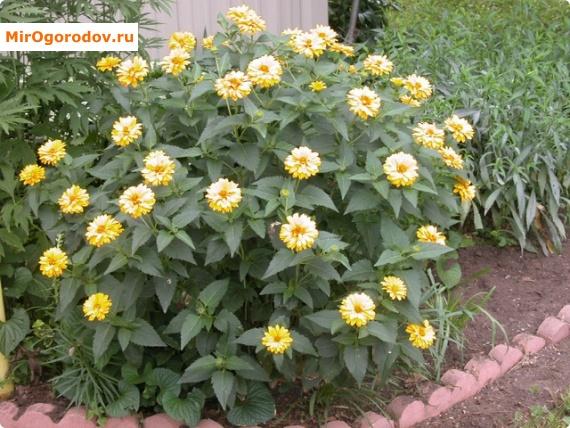

Dory bush surrounded by perennial flowering partners
Care secrets
Perennial heliopsis - unassuming in care, but responsive to attention. Top dressing at the beginning of the growing season with organic fertilizers stimulates the growth of the greenery of the bush, phosphorus-potassium feed during the budding period will provide a generous and long flowering.
Watering is needed moderate, but regular, especially in drought. Varieties with large double inflorescences are demanding for moisture - with a lack of water, they fade faster.
A bush of flowers will always be neat and fresh if you tie it up and remove faded baskets in a timely manner. For the winter, the perennial is cut under a stump, if desired, they are covered.
Happy Admin (Administrator) Moscow, Russia, on the site since 11.01.2017
Heliopsis is a sunny and joyful flower that adorns the garden in cloudy and sunny weather. The name of the flower comes from the Greek helios and opsis, which translated into Russian - similar to the sun, but its homeland is not Greece, but North America.
You can decorate a flower bed or corner of the garden with this perennial, placing it in the background, giving way to undersized flowers. Spectacular compositions are obtained by creating chaotic plantings with contrasting shades of flowers and leaves. Heliopsis blooms all summer long, does not require special care, and therefore it is doubly valuable, especially where there is no opportunity to pay much attention to flowers.
Heliopsis landing
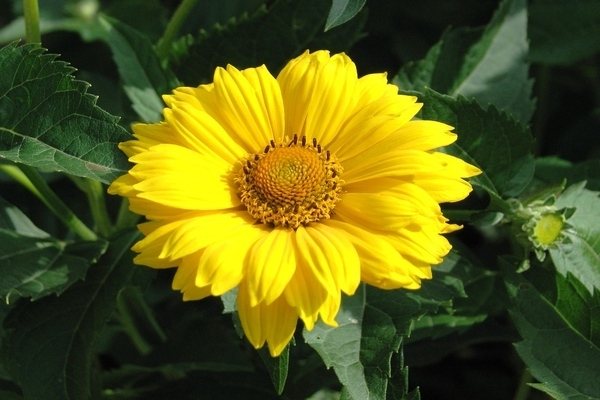

Optimal planting time.
Seedlings are transplanted under the open sky at a time when repeated frosts are no longer likely to threaten, namely, from May 15 to the beginning of the first summer month. For planting, a well-lit place is selected, which is protected from a draft. The soil should be clayey, moisture and air permeable. For this purpose, a layer of crushed stone (20 cm) is laid under the soil at the site of cultivation, then it is covered with sand. The even drainage layer is covered with clay soil, previously combined with compost fertilizer.
How to correctly plant heliopsis.
In the place prepared for planting, pits are dug for planting, the interval between them is 0.3-0.5 m. Deep in the holes should be dug so that the root system of the seedlings along with an earthen lump can easily fit in them. After planting seedlings, you need to fill up all the holes with the required amount of soil, which must be tamped and watered. If you grow varieties of strong growth, props are mandatory installed near the bushes during planting.
Features of heliopsis
The genus Heliopsis has about 15 species of annuals and perennials. The varieties differ from each other in height and look great in every flower bed. Heliopsis belongs to the Asteraceae or Asteraceae family and is distinguished by a straight-growing stem with many branches that adorn the lush flowers. The most common type of this plant grows up to 90 cm in height and has white leaves. Other varieties have green leaves with an oblong shape and grooves along the edges. The root system is mainly represented by adventitious roots (fibrous).
The flowers of the perennial are yellow with an orange tint. Their baskets can be simple, collected in inflorescences, or terry. The flowering period begins in the last days of June; in warm conditions, heliopsis blooms earlier. Duration of flowering - up to 75 days.
Heliopsis varieties
The only decorative type of heliopsis compensates for the large number of varieties bred on its basis. Breeding is carried out all over the world, but the most famous varieties of sunflower are obtained in the UK, where heliopsis is a very popular garden perennial. Many of the varieties have received the prestigious Royal Horticultural Society awards.
Varieties differ in color and shape of inflorescences, shade of leaves and height of individual bushes. The most popular of them are:
- "Light of Loddon" is a short (up to 1 m) perennial with large spear-shaped leaves and small (up to 8 cm) golden yellow flowers that bloom in mid-summer.
- "Benzinggold" (Benzinggold) - a large ornamental plant, distinguished by semi-double inflorescences with an orange center and yellow edges.
- "Waterperry Gold" (Waterperry Gold) - reaches 1.2 m in height, is distinguished by a very long (throughout the summer) flowering. Inflorescences are semi-double, rich yellow.
- Sonnenglut (Sun Flame) is a medium-high (up to 1.2 m) variety with dark green glossy leaves and yellow-orange flowers.
- "Loraine Sunshine" or "Winter Sun" (Winter sun) is a very beautiful compact (up to 0.9 m) perennial, the main highlight of which is variegated leaves. The leaf plate is painted in a silvery-gray color; dark green veins stand out brightly against a light background. Yellow chamomile-shaped inflorescences appear in June and bloom until early fall.


D. Light of Loddon, G. Benzinggold, G. Sonnenglut, D. Loraine Sunshine
- "Spitzentänzerin" or "Ballerina" (Ballerina) is a herb about 1.2 m high, decorated with large dark green leaves and golden inflorescences.
- "Prairie Sunset" (Sunset on the prairie) - golden yellow flowers with an orange center, the shoots are painted in a dark green shade with an admixture of purple. The height of an individual bush can reach 1.6 m, the flowering time is from June to early September.
- Summer Sun is a drought tolerant variety with small double, bright yellow flowers ranging in size from 5 to 7 cm. The total plant height is about 1 m. Thanks to its straight, stable stems, the variety is excellent for cutting.
- Sunburst is another variegated variety: dark green veins stand out against the creamy background of the leaf. Inflorescences are simple, golden yellow. The height of the bush is about 0.9 m.
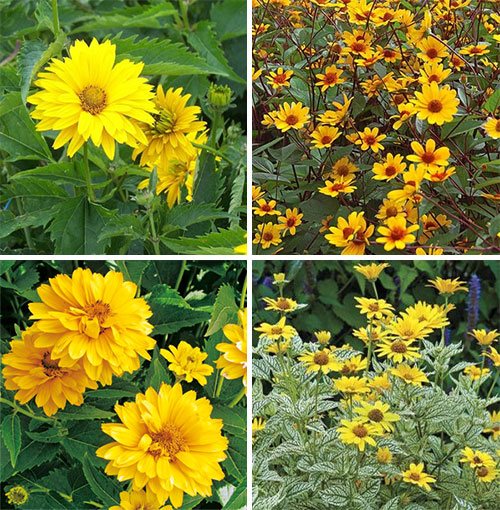

G. "Spitzentänzerin", G. "Prairie Sunset", G. "Summer Sun", G. "Sunburst"
- "Venus" (Venus, Venus) is a fairly tall (up to 1.2 m) variety with strong stems bearing large (12 cm) golden-yellow inflorescences.
- "Asahi" (Asahi) is a very decorative variety with numerous yellow-orange double inflorescences. The average height of a single plant is 0.8 m.
- "Summer Nights" - bright yellow inflorescence with an orange center.
- "Sommerzwerg" (Summer dwarf) is a dwarf (no more than 0.6 m) variety with a large number of golden yellow flowers and dense dark green foliage.


G. "Venus", G. "Asahi", G. "Summer Nights", G. "Sommerzwerg"
The sunflower is a luxurious plant with bright flowers framed by dense greenery, which looks great both in single plantings and in flower beds. Heliopsis can be planted as a tapeworm on a sunny lawn or lawn. A large bush will become an excellent dominant among open spaces, and yellow flowers will dilute the monotony of greenery.
As for group landings, a wide variety of options are possible. Flower beds made up of various representatives of the aster family look good: heliopsis, echinacea, calimeris, gailardia, pyrethrum. Particularly interesting is the combination of yellow heliopsis inflorescences with pink and purple flowers of Echinacea and pyrethrum. The undoubted advantage of such a flower bed is easy care, since all of the above plants require approximately the same conditions.
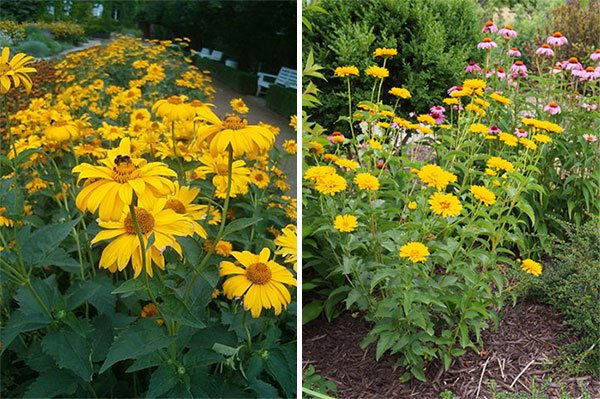

It is not forbidden to plant varieties of compositions, however, in this case, you should pay attention to the flowering time of each species and the height of the plants. Since heliopsis is quite tall, it should be placed in the background so that it does not interfere with smaller flowers. Lilies, phloxes, veronica, bells, large cornflowers are well suited as flower partners for sunflower.


Heliopsis can also be planted near a house or outbuildings. Due to its rather large size, the plant is able to hide unsightly facades, but, at the same time, it will not block the windows and prevent the penetration of sunlight. Placed along the fence, a perennial can be a kind of hedge that blooms beautifully in summer.
Many varieties of heliopsis are perfect for cutting - large flowers on high stems stand for a long time in a vase and do not lose their freshness.
Possible growing problems
A perennial can also have problems and diseases, although this is a rarity for this plant.
The most common difficulties:
- Leaf problems in variegates. They arise as a result of excessive watering or damage by certain diseases.
- Pests. Heliopsis Sunflower does not attract attention from many pests. In the heat, aphids can be affected, from which they get rid of standard insecticides - Fitoverm, Aktara.
- Diseases. The plant can be affected by powdery mildew and other fungal diseases. Take the usual measures to combat such diseases.
- Signs of improper care. If the rules are not followed, the plant can "hang" the leaves, bloom poorly, inflorescences appear small.
Variegated Heliopsis is a beautiful and unpretentious plant that even a novice florist can grow. The choice of varieties is huge, so everyone will pick up a flower to their liking.
Benefit
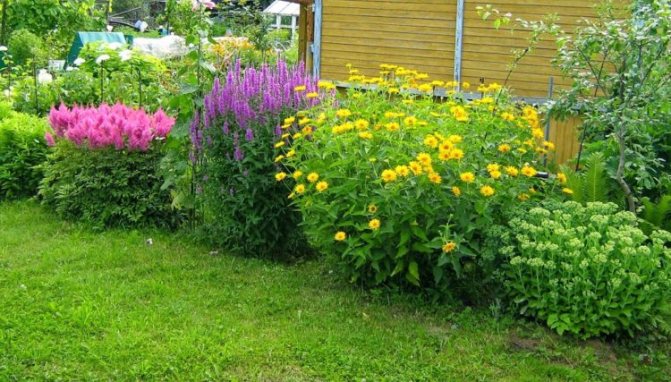

Heliopsis is, first of all, an ornamental garden plant that, without exaggeration, will successfully fit into the design of any garden (especially if the garden is made in a rustic or Provence style). It will look spectacular if planted near a wicker fence, a wooden wall or an old cart. Heliopsis goes well with sage, lyatrice, veronica, cornflowers, etc.
How to grow, care, pests and diseases


When planting heliopsis (in the form of seeds or seedlings), the following rules must be observed:
- Planting is carried out in dry and well-lit areas.
- It is necessary to plant flowers, as already mentioned, in fertile (in moderation) and well-drained soil.
- When planting seedlings, a certain distance between the bushes must be observed - at least 35 cm, and the distance between the rows is at least 50 cm.
- The best time to plant heliopsis is spring.
The big advantage of this plant is that it is extremely unpretentious, and therefore it is very easy to care for it. Here, you should also follow a few simple rules:
- you should not water the plant too often, as an excessive amount of moisture can harm it;
- tall varieties need a garter to the supports, since strong winds can break their long stems;
- during the flowering period, it is necessary to regularly remove wilted inflorescences, and in late autumn, cut the stems to ground level;
- it is necessary to remember about loosening and regular weeding of the soil around the plants;
- about once every 20 days, it is advisable to feed the plantings with mineral or organic fertilizers.
As for protection from pests, you should know that the beautiful flowers of heliopsis and their bright leaves can suit the taste of aphids, which systemic insecticides will help get rid of.
In fact, this plant is not very susceptible to diseases, but sometimes dark spots can be seen on its leaves, which may indicate rust, or a light gray bloom, which may indicate a powdery mildew attack. In this case, the affected shoots must be cut off, and the healthy ones must be treated with a solution of Fundazole copper or vitriol (this can be done for preventive purposes in the spring).
Varieties and varieties of heliopsis with photos
There are many varieties of heliopsis, the most common of which are the following:
- Sunflower. This plant can be recognized by the bright yellow flowers that literally cover the bush. The structure of the inflorescence can be both double and semi-double, and there are also ordinary, smooth varieties. This culture blooms almost all summer.
- Rough... As the name implies, the stems and leaves of this plant are covered with villi that are rough and rough to the touch. The flowers are large, sunny yellow.
- Lorraine Sunshine. You can distinguish this type of heliopsis from others by its white-green leaves, densely covered with veins, and meter-long stems. The flowers in this culture are simple and chamomile-like with convex orange centers and yellow petals.
- Summer. This is the brightest representative of heliopsis, its large flowers really resemble a sunflower, only slightly reduced in size. The inflorescences are densely located, and persist throughout the summer.
- Asahi. Such a bush will be more compact, and the flowers will be medium-sized, with bright petals.
- Gold balls. Such a culture is a large sheaf of leaves, with flowers densely located between them. Inflorescences appear in early summer and retain their original appearance until mid-autumn.
- Variegated. The bushes of this type of plant are not the largest, the stems reach a length of 90 cm and are covered with foliage with a huge number of veins, which makes it almost white. The flowers are large and bright yellow.


Heliopsis sunflower
Any of the listed types of heliopsis will not go unnoticed when planting in a flower bed and will look great both as an independent planting and in combination with other plants.
The best place to grow
Heliopsis is absolutely not a capricious plant, planting and caring for it will not be difficult. One has only to choose the right place and soil, and the bulk of the work is done, and the foundation for successful cultivation is laid.
Location and lighting
Considering that the plant came to us from hot countries, the places for planting it must be sunny.The herbaceous perennial grows best in open and even arid areas.
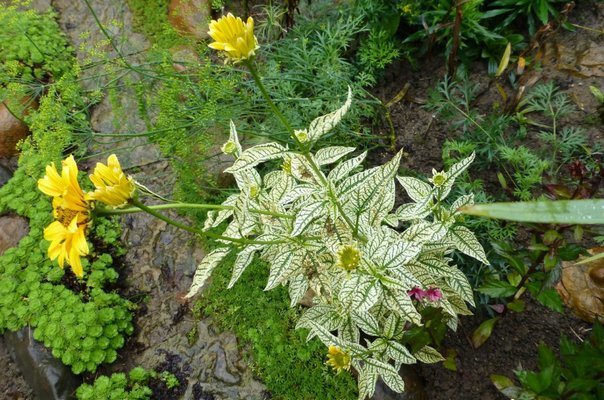

Soil for heliopsis
The plant prefers fertile, preferably loamy soil. It is very important that the soil is well drained, as stagnant water can be detrimental to the plant.
Heliopsis in the flowerbed
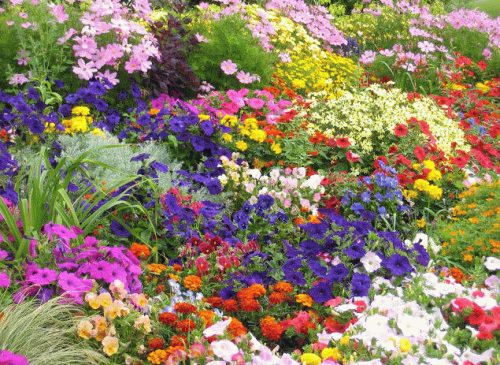

Sunny flowers of Heliopsis will set a bright mood for a flower bed or garden, if they are correctly arranged. Very often these flowers are used in the decoration of the courtyard in a rustic style. For this, Heliopsis bushes are planted along wicker fences or walls, and they can also function as a hedge.
Those who like monochromatic flower beds can plant calendula, rudbeckia or a string next to this flower. If the plans include contrast and multicolor, you can plant sage, veronica, liatris, asters, delphinium and other plants with Heliopsis.
Cut Heliopsis retains its fresh appearance for 10 days, therefore it is preferred to use it when drawing up bouquets. Despite all the benefits and beauty of this plant, it is not very common among gardeners. Probably, the reason lies in the fact that there are a lot of such "sunny" flowers, and not all growers opt for Heliopsis.
A beautifully flowering relative of a sunflower
Of more than a dozen known species in culture, one has become widespread - sunflower heliopsis. It was he who became the ancestor of many cultivars and hybrids.
A perennial herb belongs to the Astrovye family, forms a lush bush that grows up to one and a half meters in height. At the top of the stem, it dissolves inflorescences-baskets with a diameter of up to 9 cm from reed flowers of all shades of yellow. At the peak of flowering, their number on each plant reaches 40 pieces. Along with flowering varieties, decorative heliopsis with variegated variegated leaves, white with green veins, is gaining increasing popularity.
Bright sheaves of flowers are planted along fences, they are suitable for decorating the background of flower beds, creating volume in rabatki and mixborders. In group plantings, it is combined with annual crops in tone and contrasting colors.
It is interesting! The German breeder with a philosophical education Karl Forster gave a start to life for the heliopsis flower. The philosopher gardener, tired of the fashion for exquisite flowers, was attracted to the perennial by endurance, modest but stable decorativeness, the color of the sun.
Perennial Heliopsis is able to live in one place for decades, the bush grows rapidly, multiplies by self-seeding. The average duration of flowering is 2.5 months; in a warm, humid climate, flowers do not fade until frost.
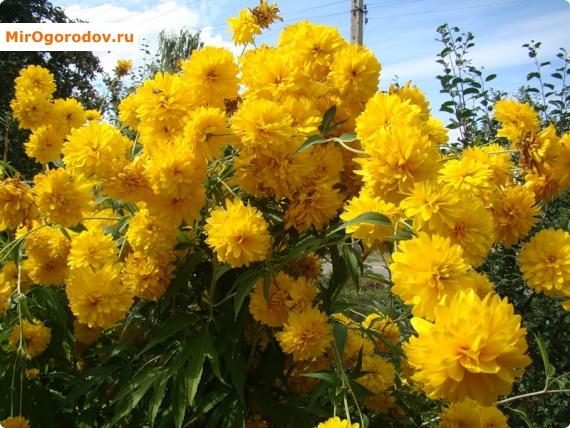

In the photo, the variety Golden balls

